Abstract
Human operant research is typically viewed as fitting somewhere between the end points of a basic-to-applied continuum. Viewed in this way, the major role of human operant research is to determine the conditions under which principles discovered with animals also hold with humans. Relative to the basic and applied end points, which have defined the major journals and graduate training programs in Behavior Analysis, the human operant area has not been strong since the late 1950's when a scientifically based application was only an exciting possibility. However, application quickly became a reality and to some extent it replaced the major role of human operant research. After about 15 years of focusing on the basic and applied end points, an increasing number of behavior analysts are concerned about the large content of psychology (e.g., social and verbal behavior) between the end points and the continued growth of Behavior Analysis. Basic research in social and verbal behavior should ordinarily begin with the human instead of a lower animal, because the human is the most qualified and prepared subject in the sense that most complex social and verbal behaviors are more accessible in humans. This new role for basic human research of initiating rather than only replicating, could result in a rebuilding of the “bridge” between basic and applied, and contribute to the growth of Behavior Analysis in terms of extensions to new content areas, methods, and the followers it would reach in these areas.
Full text
PDF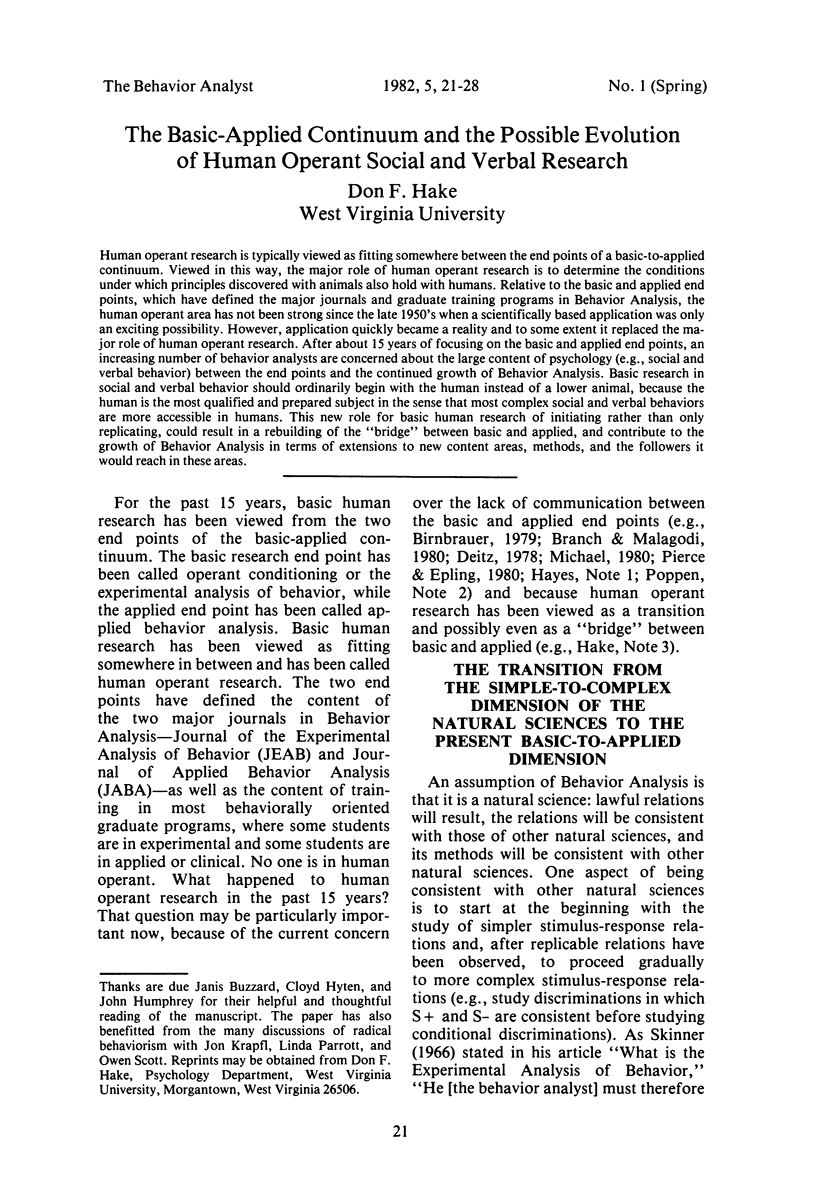
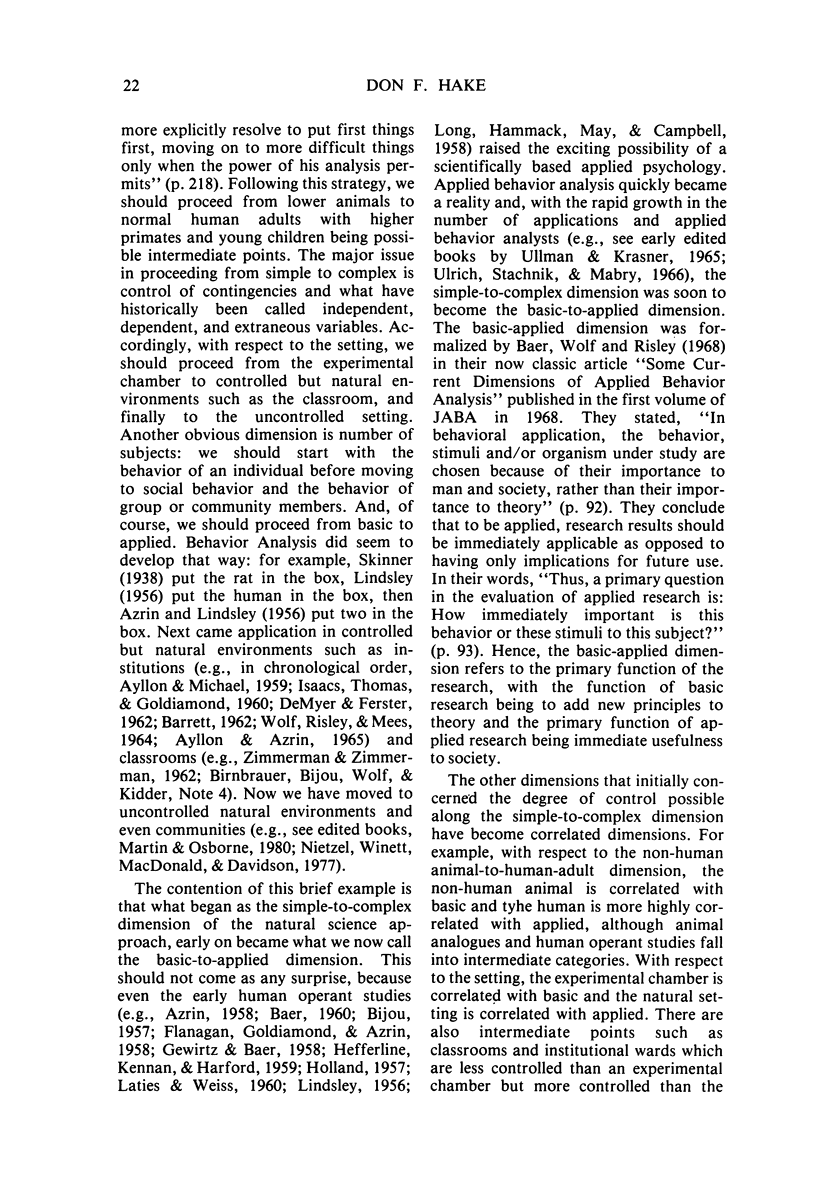
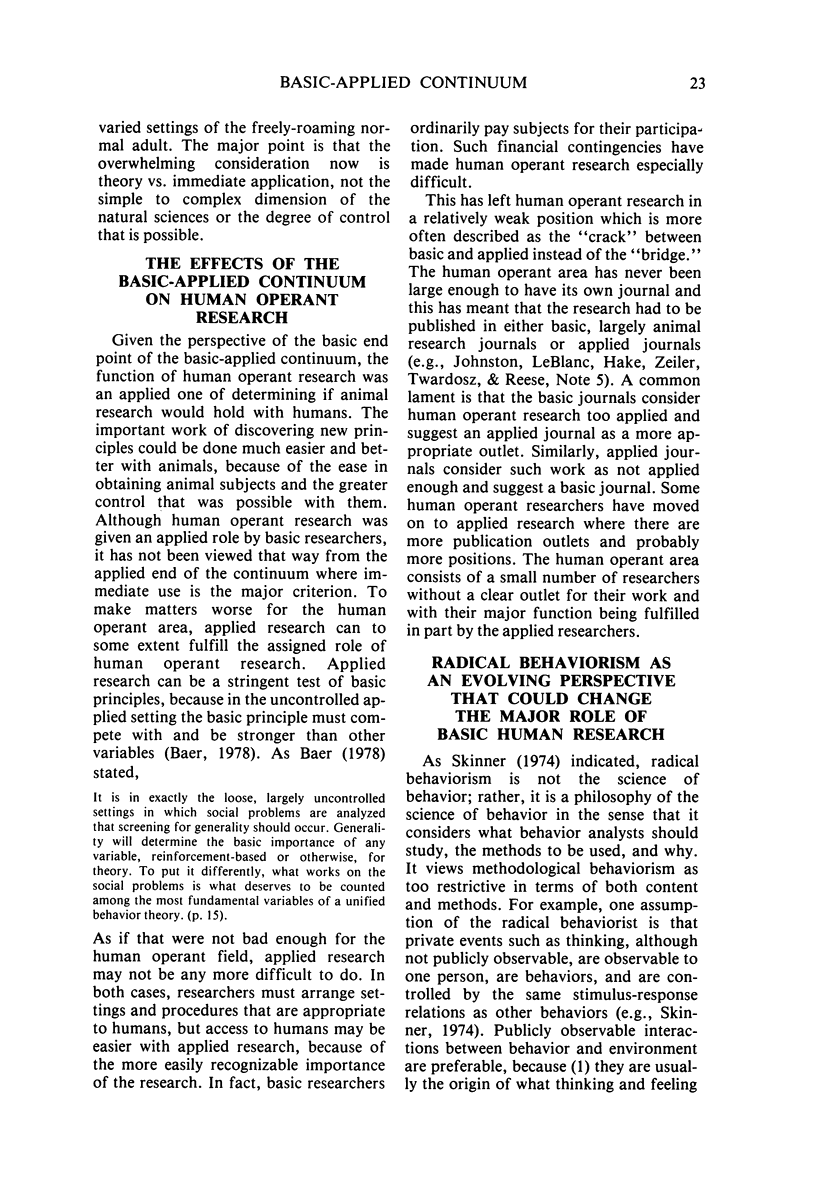
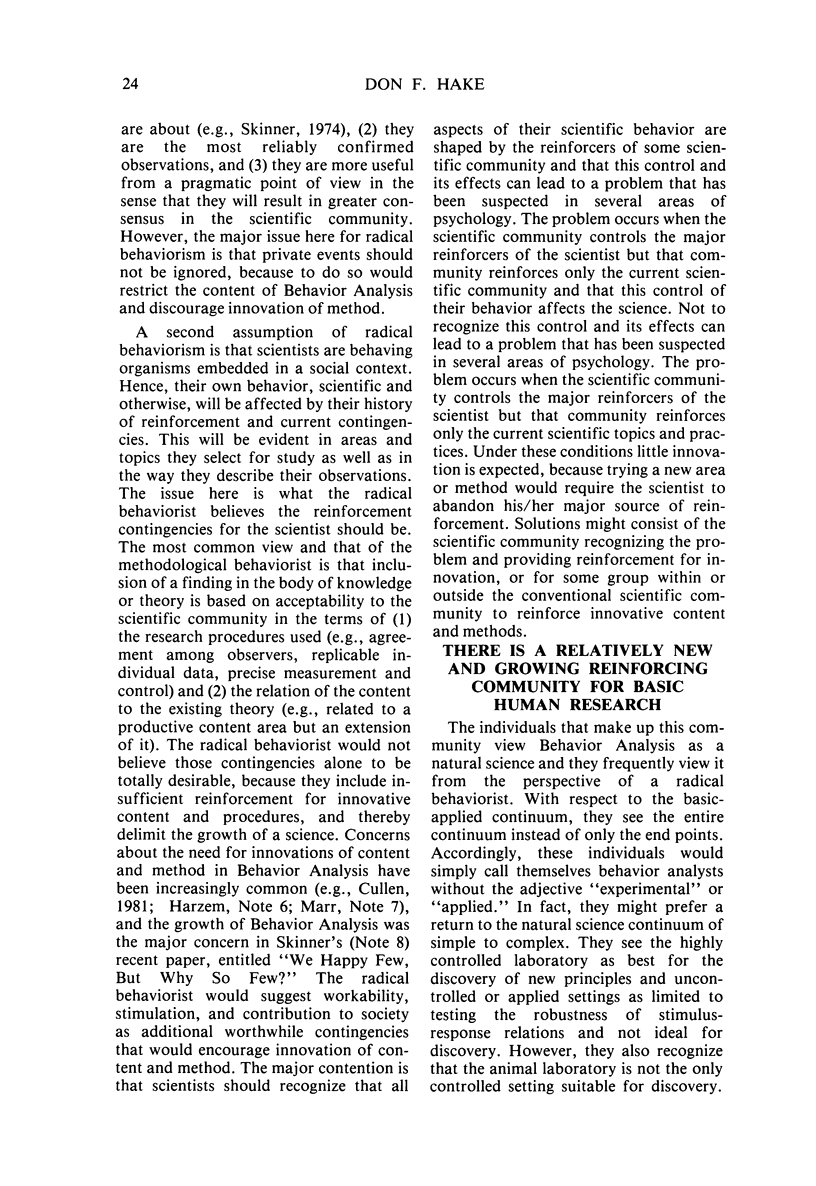
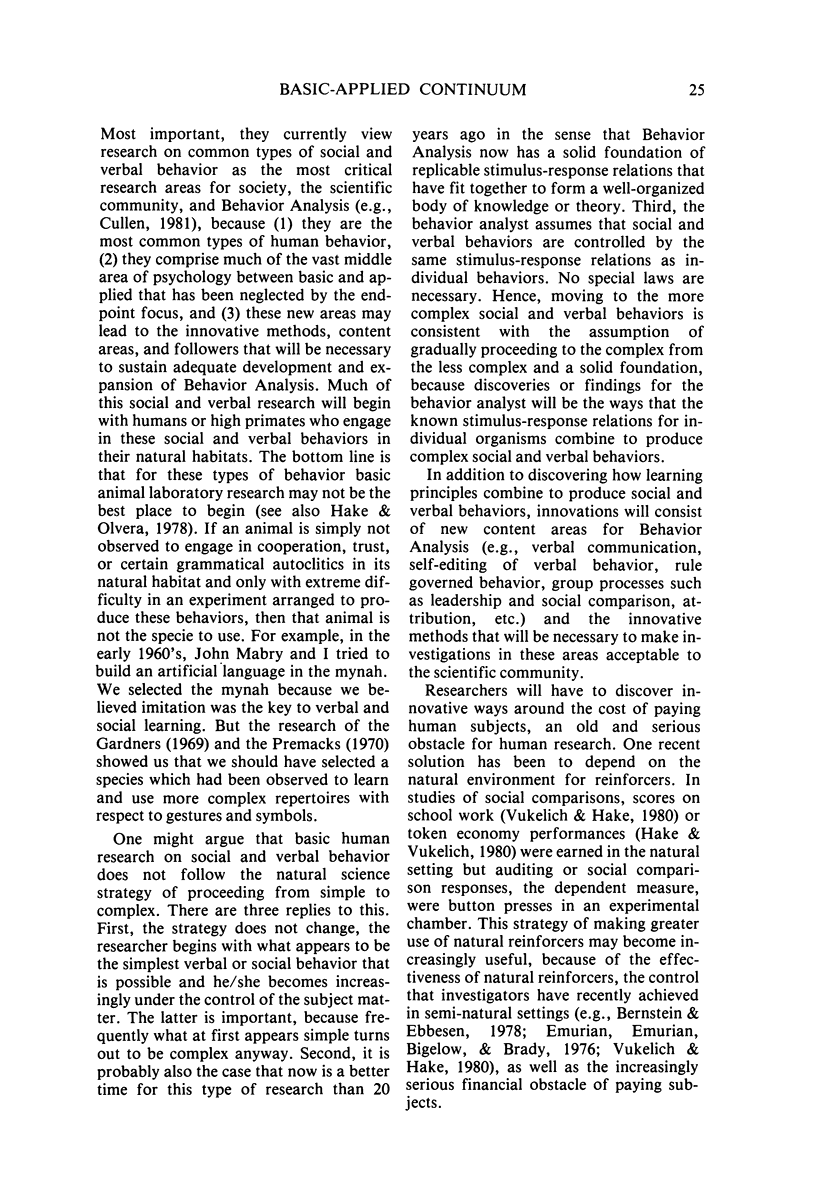
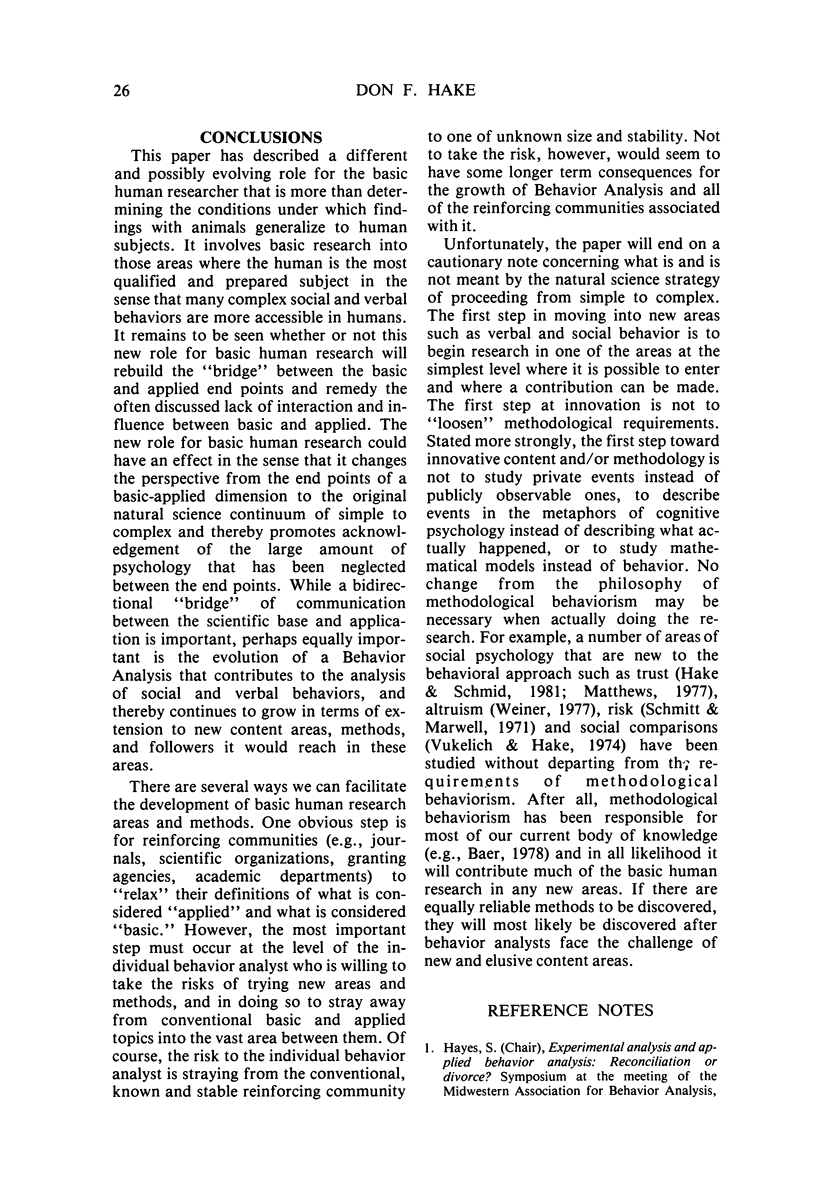
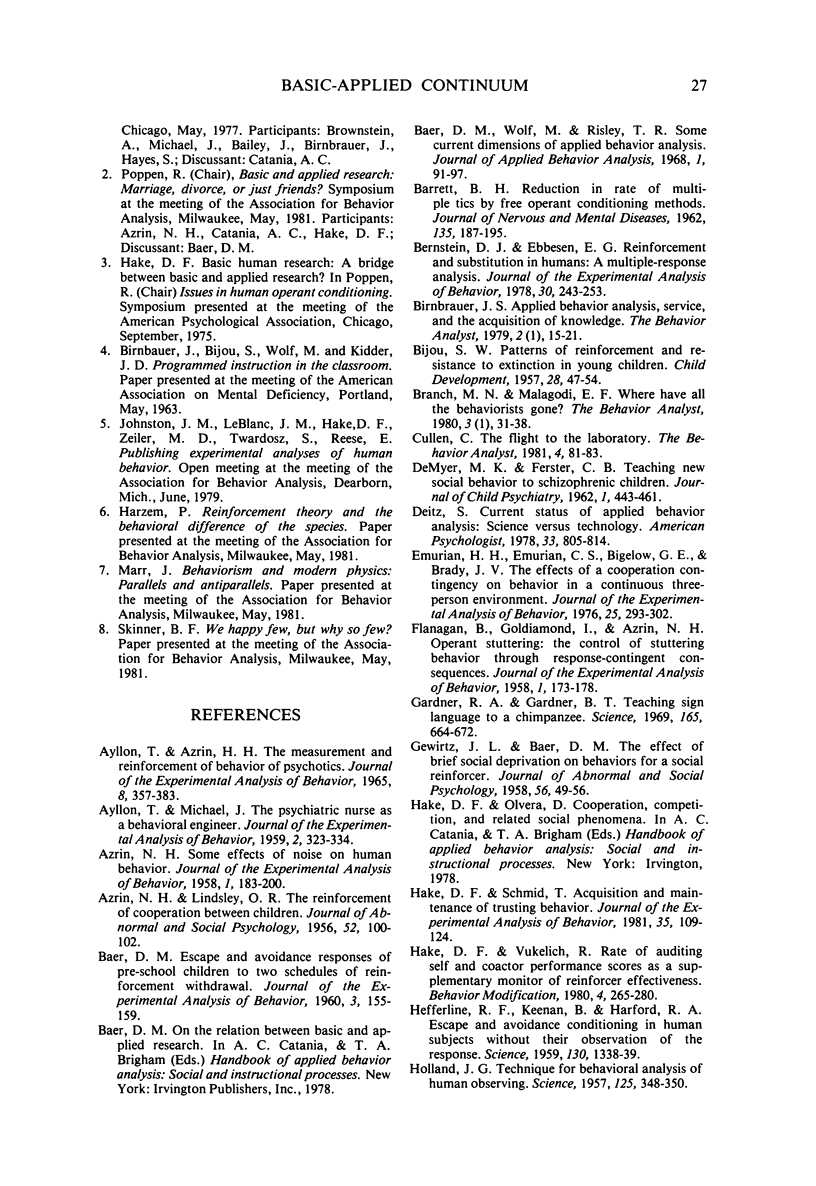
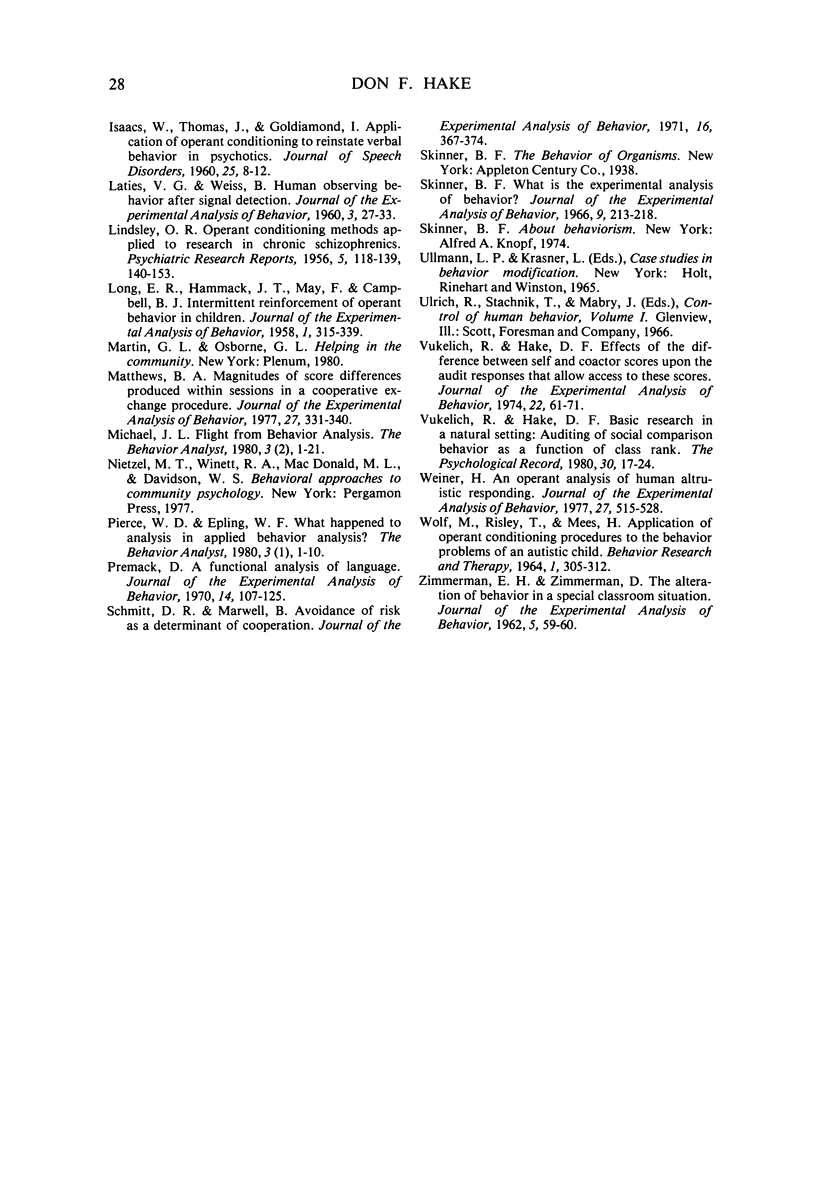
Selected References
These references are in PubMed. This may not be the complete list of references from this article.
- AYLLON T., MICHAEL J. The psychiatric nurse as a behavioral engineer. J Exp Anal Behav. 1959 Oct;2:323–334. doi: 10.1901/jeab.1959.2-323. [DOI] [PMC free article] [PubMed] [Google Scholar]
- AZRIN N. H., LINDSLEY O. R. The reinforcement of cooperation between children. J Abnorm Psychol. 1956 Jan;52(1):100–102. doi: 10.1037/h0042490. [DOI] [PubMed] [Google Scholar]
- Ayllon T., Azrin N. H. The measurement and reinforcement of behavior of psychotics. J Exp Anal Behav. 1965 Nov;8(6):357–383. doi: 10.1901/jeab.1965.8-357. [DOI] [PMC free article] [PubMed] [Google Scholar]
- Azrin N. H. Some Effects of Noise on Human Behavior. J Exp Anal Behav. 1958 Apr;1(2):183–200. doi: 10.1901/jeab.1958.1-183. [DOI] [PMC free article] [PubMed] [Google Scholar]
- BAER D. M. Escape and avoidance response of pre-school children to two schedules of reinforcement withdrawal. J Exp Anal Behav. 1960 Apr;3:155–159. doi: 10.1901/jeab.1960.3-155. [DOI] [PMC free article] [PubMed] [Google Scholar]
- BARRETT B. H. Reduction in rate of multiple tics by free operant conditioning methods. J Nerv Ment Dis. 1962 Sep;135:187–195. [PubMed] [Google Scholar]
- BIJOU S. W. Patterns of reinforcement and resistance to extinction in young children. Child Dev. 1957 Mar;28(1):47–54. doi: 10.1111/j.1467-8624.1957.tb04830.x. [DOI] [PubMed] [Google Scholar]
- Baer D. M., Wolf M. M., Risley T. R. Some current dimensions of applied behavior analysis. J Appl Behav Anal. 1968 Spring;1(1):91–97. doi: 10.1901/jaba.1968.1-91. [DOI] [PMC free article] [PubMed] [Google Scholar]
- Bernstein D. J., Ebbesen E. B. Reinforcement and substitution in humans: a multiple-response analysis. J Exp Anal Behav. 1978 Nov;30(3):243–253. doi: 10.1901/jeab.1978.30-243. [DOI] [PMC free article] [PubMed] [Google Scholar]
- Birnbrauer J. S. Applied behavior analysis, service and the acquisition of knowledge. Behav Anal. 1979 Spring;2(1):15–21. doi: 10.1007/BF03391830. [DOI] [PMC free article] [PubMed] [Google Scholar]
- Branch M. N., Malagodi E. F. Where have all the behaviorists gone? Behav Anal. 1980 Spring;3(1):31–38. doi: 10.1007/BF03392376. [DOI] [PMC free article] [PubMed] [Google Scholar]
- Cullen C. The flight to the laboratory. Behav Anal. 1981 Spring;4(1):81–83. doi: 10.1007/BF03391856. [DOI] [PMC free article] [PubMed] [Google Scholar]
- Emurian H. H., Emurian C. S., Bigelow G. E., Brady J. V. The effects of a cooperation contingency on behavior in a continuous three-person environment. J Exp Anal Behav. 1976 May;25(3):293–302. doi: 10.1901/jeab.1976.25-293. [DOI] [PMC free article] [PubMed] [Google Scholar]
- Flanagan B., Goldiamond I., Azrin N. Operant Stuttering: the Control of Stuttering Behavior through Response-contingent Consequences. J Exp Anal Behav. 1958 Apr;1(2):173–177. doi: 10.1901/jeab.1958.1-173. [DOI] [PMC free article] [PubMed] [Google Scholar]
- GEWIRTZ J. L., BAER D. M. The effect of brief social deprivation on behaviors for a social reinforcer. J Abnorm Psychol. 1958 Jan;56(1):49–56. doi: 10.1037/h0047188. [DOI] [PubMed] [Google Scholar]
- Gardner R. A., Gardner B. T. Teaching sign language to a chimpanzee. Science. 1969 Aug 15;165(3894):664–672. doi: 10.1126/science.165.3894.664. [DOI] [PubMed] [Google Scholar]
- HEFFERLINE R. F., KEENAN B., HARFORD R. A. Escape and avoidance conditioning in human subjects without their observation of the response. Science. 1959 Nov 13;130(3385):1338–1339. doi: 10.1126/science.130.3385.1338. [DOI] [PubMed] [Google Scholar]
- HOLLAND J. G. Technique for behavioral analysis of human observing. Science. 1957 Feb 22;125(3243):348–350. doi: 10.1126/science.125.3243.348-a. [DOI] [PubMed] [Google Scholar]
- Hake D. F., Schmid T. L. Acquisition and maintenance of trusting behavior. J Exp Anal Behav. 1981 Jan;35(1):109–124. doi: 10.1901/jeab.1981.35-109. [DOI] [PMC free article] [PubMed] [Google Scholar]
- ISAACS W., THOMAS J., GOLDIAMOND I. Application of operant conditioning to reinstate verbal behavior in psychotics. J Speech Hear Disord. 1960 Feb;25:8–12. doi: 10.1044/jshd.2501.08. [DOI] [PubMed] [Google Scholar]
- Laties V. G., Weiss B. Human Observing Behavior after Signal Detection. J Exp Anal Behav. 1960 Jan;3(1):27–33. doi: 10.1901/jeab.1960.3-27. [DOI] [PMC free article] [PubMed] [Google Scholar]
- Long E. R., Hammack J. T., May F., Campbell B. J. Intermittent reinforcement of operant behavior in children. J Exp Anal Behav. 1958 Oct;1(4):315–339. doi: 10.1901/jeab.1958.1-315. [DOI] [PMC free article] [PubMed] [Google Scholar]
- Matthews B. A. Magnitudes of score differences produced within sessions in a cooperative exchange procedure. J Exp Anal Behav. 1977 Mar;27(2):331–340. doi: 10.1901/jeab.1977.27-331. [DOI] [PMC free article] [PubMed] [Google Scholar]
- Michael J. Flight from behavior analysis. Behav Anal. 1980 Fall;3(2):1–21. doi: 10.1007/BF03391838. [DOI] [PMC free article] [PubMed] [Google Scholar]
- Premack D. A functional analysis of language. J Exp Anal Behav. 1970 Jul;14(1):107–125. doi: 10.1901/jeab.1970.14-107. [DOI] [PMC free article] [PubMed] [Google Scholar]
- Schmitt D. R., Marwell G. Avoidance of risk as a determinant of cooperation. J Exp Anal Behav. 1971 Nov;16(3):367–374. doi: 10.1901/jeab.1971.16-367. [DOI] [PMC free article] [PubMed] [Google Scholar]
- Skinner B. F. What is the experimental analysis of behavior? J Exp Anal Behav. 1966 May;9(3):213–218. doi: 10.1901/jeab.1966.9-213. [DOI] [PMC free article] [PubMed] [Google Scholar]
- Vukelich R., Hake D. F. Effects of the difference between self and coactor scores upon the audit responses that allow access to these scores. J Exp Anal Behav. 1974 Jul;22(1):61–71. doi: 10.1901/jeab.1974.22-61. [DOI] [PMC free article] [PubMed] [Google Scholar]
- Weiner H. An operant analysis of human altruistic responding. J Exp Anal Behav. 1977 May;27(3):515–528. doi: 10.1901/jeab.1977.27-515. [DOI] [PMC free article] [PubMed] [Google Scholar]
- Zimmerman E. H., Zimmerman J. The alteration of behavior in a special classroom situation. J Exp Anal Behav. 1962 Jan;5(1):59–60. doi: 10.1901/jeab.1962.5-59. [DOI] [PMC free article] [PubMed] [Google Scholar]


